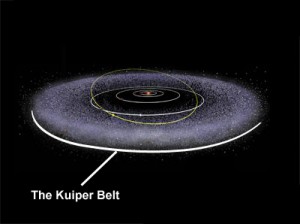What could be the reason for travelling through the space for more than 9 years, arriving almost to the edge of our Solar System? According to NASA, one of the highest priorities for the solar system exploration is to study the Kuiper Belt, that has been defined as a mysterious relic of the solar system formation.Going into details, the Kuiper Belt is a disc-shaped region of icy bodies that includes also the dwarf planet Pluto with its moons and an estimated trillion of comets, beyond the orbit of Neptune.
It is important to notice that comets from the Kuiper Belt orbit approximately in the plane in which most of the planets orbit the sun and actually short-period comets (which take less than 200 years to orbit the Sun) originate in this region. The other large icy objects populating the Kuiper Belt probably are remnants from the first accretional phases of the solar system in its outer and less dense parts, about 4.6 billion years ago.
The Kuiper Belt was the destination of the Nasa New Horizons Mission, after a long journey that started on Jan. 19, 2006, and culminated with a Pluto flyby on July 14,2015.
Studying how ice dwarf planets like Pluto and Kuiper Belt bodies have evolved over time can help scientists understand the origins and the outskirts of our Solar System more deeply. In particular, the main objective of the mission, at least in its first part, is to observe and analyze Pluto and its largest moon Charon, that are called Binary KBOs (Kuiper Belt Objects). The spacecraft should provide geological and chemical analysis for the surfaces of the two objects, trying also to detect their surface temperature. In addition New Horizons has been equipped with specific instruments that can study in detail the thin Pluto atmosphere, that has been already detected, but the mission could also reveal if Charon has an atmosphere too.
New Horizons is currently providing a lot of scientific data about Pluto and Charon observation thanks to its advanced instruments, but next year a challenging extended mission could be approved. Nasa could change New Horizons trajectory to operate the first flyby ever of 2014 MU69, a tiny frozen world that has been discovered in 2014, 8 years after the spacecraft launch.
In the next weeks it could be of great interest to go deeper into the description of New Horizons, trying to put in evidence the main elements of its payload that is composed of 7 different instruments.
Each one of them has been designed for specific measurements and analysis and so far they have provided meaningful and fascinating images that have been really popular beyond their scientific value.
The image above is just an example of what have been captured during these last months by the imaging systems of New Horizons, and every single image can be processed and manipulated to extract more information thanks to modern data processing methods.
[simple-staff-list group="antoniovecoli"]



